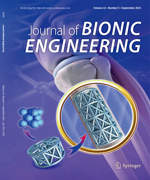Underwater robot is a new research field which is emerging quickly in recent years. Previous researches in this field focus on Remotely Operated Vehicles (ROVs), Autonomous Underwater Vehicles (AUVs), underwater manipulators, etc. Fish robot, which is a new type of underwater biomimetic robot, has attracted great attention because of its silence in moving and energy efficiency compared to conventional propeller-oriented propulsive mechanism.
However, most of researches on fish robots have been carried out via empirical or experimental approaches, not based on dynamic optimality. In this paper, we proposed an analytical optimization approach which can guarantee the maximum propulsive velocity of fish robot in the given parametric conditions. First, a dynamic model of 3-joint (4 links) carangiform fish robot is derived, using which the influences of parameters of input torque functions, such as amplitude, frequency and phase difference, on its velocity are investigated by simulation. Second, the maximum velocity of the fish robot is optimized by combining Genetic Algorithm (GA) and Hill Climbing Algorithm (HCA). GA is used to generate the initial optimal parameters of the input functions of the system. Then, the parameters are optimized again by HCA to ensure that the final set of parameters is the “near” global optimization. Finally, both simulations and primitive experiments are carried out to prove the feasibility of the proposed method.

 Table of Content
Table of Content
 Table of Content
Table of Content